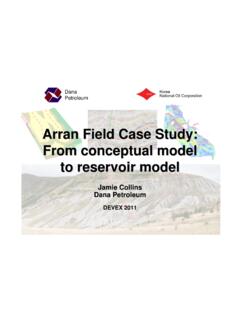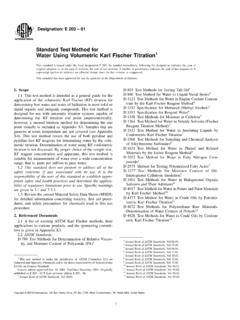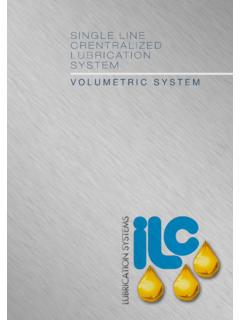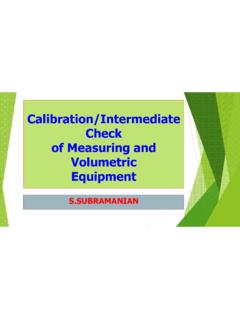Transcription of Estimated Fluid Contact Using Material Balance Technique ...
1 Panteha Ghahri Guillaume Berthereau Estimated Fluid Contact Using Material Balance Technique & volumetric calculation improves reservoir management Plan 1 Objective Gryphon reservoir -Overview The proposed approach( Material Balance Modelling & volumetric calculation ) Comparison the calculated Fluid contacts with 4D seismic and simulation model 2 Outline Estimate WOC & GOC for Gryphon area Using an analytical approach Direct measurement of the Fluid contacts is costly and sometimes can be very challenging. It is also useful to validate the simulation model 3 Objective Production started from 1993 Original oil column 190 ft Heavy Oil (21 deg API) Viscous oil (6 cP) Long tail end production at high watercut Long term plan to produce across a floating facility (first permanently moored FPSO) Developed exclusively with horizontal production wells Aquifer well to provide compatible injection water/large connected aquifer Water & gas much more mobile than the oil in the reservoir 4 Gryphon reservoir overview Gas+ Oil Production Gas Injection Aquifer Influx + Water Injection Very Limited/Aquifer Index WOC GOC WOC GOC The Original Oil Rim Thickness Gas+ Oil Production (Gas Movement)
2 Moved GOC Moved WOC Moved GOC Moved WOC 5 Material Balance modelling Gryphon and nearby field 6 Material Balance & volumetric calculation Gas, 1-Swi Oil, 1-Swi Water Water, Sor Oil, 1-Swi Oil, 1-Swi-Sgr Gas, 1-Swi Initial Current 7 Material Balance & volumetric calculation Material Balance calculation Oil Produced: 121 MMbbl Oil left inside the water zone:14% of STOIIP Oil moved up to Gas zone:10% of STOIIP Remaining Oil: 47% of STOIIP 8 WOC & GOC vs. Time 5200530054005500560057005000550060006500 70007500800085009000 Completion Interval of wells (TVDss )WOC-1993 WOC-2011 Data from last test:GOR =402 WOR=89%PI=178 GOC-2011 GOC-19939 Well position vs. WOC & GOC W1 W2 10 Completion interval vs. WOC & GOC and WOR% 11 Completion interval vs. WOC & GOC and GOR The strategy is to keep the existing wells placed within the oil rim by controlling the movements of the GOC & WOC.
3 The WOC movements are controlled by re-injecting produced water into the aquifer or the reservoir . The GOC movements are controlled by re-injecting the gas into the gas cap and operating the wells at a GOR limit. Well performance data, 4D seismic, simulation modelling and analytical calculation are used to monitor Contact movements. This understanding is applied to optimize new well placements. 12 reservoir management strategies 4D modelling Shale Shale Gas bearing Sand Oil bearing Sand Brine bearing Sand (1990) Acoustic impedance (2011) No signal in shale No signal in shale 2011-1990 synthetic Coloured inversion 4D observed theoretically only due to Fluid movement (no significant pressure change) Fluid movements over Gryphon: Gas into oil (due to production): softening Water into oil (due to production): hardening Oil into gas (water injection): hardening Acoustic impedance Hardening Softening 4D (2011-1990): seismic Sum +ve amplitude 2011-1990 (CI Full stack) oGOC / oOWC Hardening Polygon used for initial STOIIP calculation Polygon used to calculate STOIIP, input to Material Balance 4D showing water movement into the oil leg due to: production water injection 4D (2011-1990).
4 Seismic / simulation model Sum +ve amplitude 2011-1990 (CI Full stack) oGOC / oOWC Column height (water in oil leg) 2011-1990 Hardening Polygon used for initial STOIIP calculation Decent qualitative match between simulation model and 4D seismic 4D and Fluid sections Hardening Softening oGOC oOWC Moved OWC HC Generally reasonable quantitative match between moved OWC from the simulation model and 4D seismic Moved Contact comparison: Material Balance and simulation model Original Simulation model* Material Balance GOC 5541 5514 (Sgas90%) , 5518 (Sgas70%) 5519 OWC 5731 5638 - 5545 5631 * Average of the moved OWC given by the simulation model Very similar moved GOC from simulation model and Material Balance (error within vertical resolution) The moved OWC between simulation model and Material Balance are in alignment.
5 Moved OWC (Sim. model) Multi-scale injectites DYKE DYKE INJECTION BRECCIA DYKE Feeder dyke system DYKE Stepped discordant base July 2, 2013 Remobilisation of the turbidites sandstone in early Frigg times Creation of multi scale (from core to seismic scale) injection wings Below seismic resolution injectites may account for a significant volume, more than expected T Sele T Balder Adapted from Hurst and Cartwright Water and gas oil contacts has been calculated Using Material Balance and volumetric calculation Contacts from Material Balance were compared with those observed from the simulation model: Moved OWC from the simulation reasonably matches 4D Moved OWC from Material Balance and simulation model are in alignment The difference is possibly associated to missing sand volume unresolved by seismic (below seismic resolution injectites) Material Balance can be used, in addition to well performance evaluation, 4D seismic and simulation modelling, to monitor the Contact movements effectively.
6 Results can be used to control well operations and placement of new wells. 19 Conclusion The authors would like to thank the partner Sojitz for its approval to present this work. We also would like to thanks our colleges who support us during this study, Steve Milner, Hope Okhuoya, Miguel Orta, David Kirby, Duncan Chedburn, Doug Smith, Tim Heijen and Fabrizio Conti. 20 Acknowledgment








